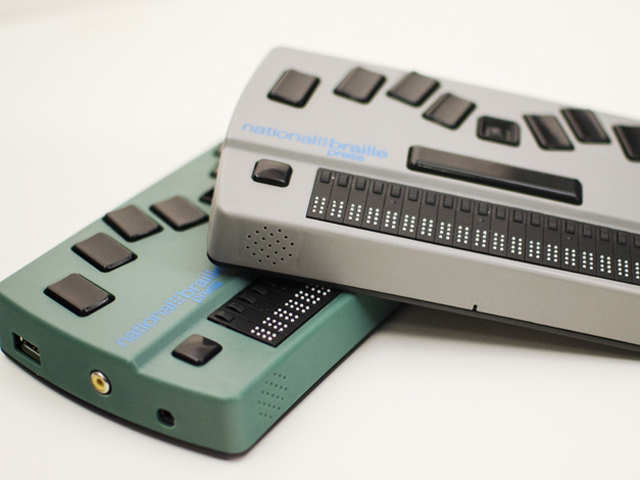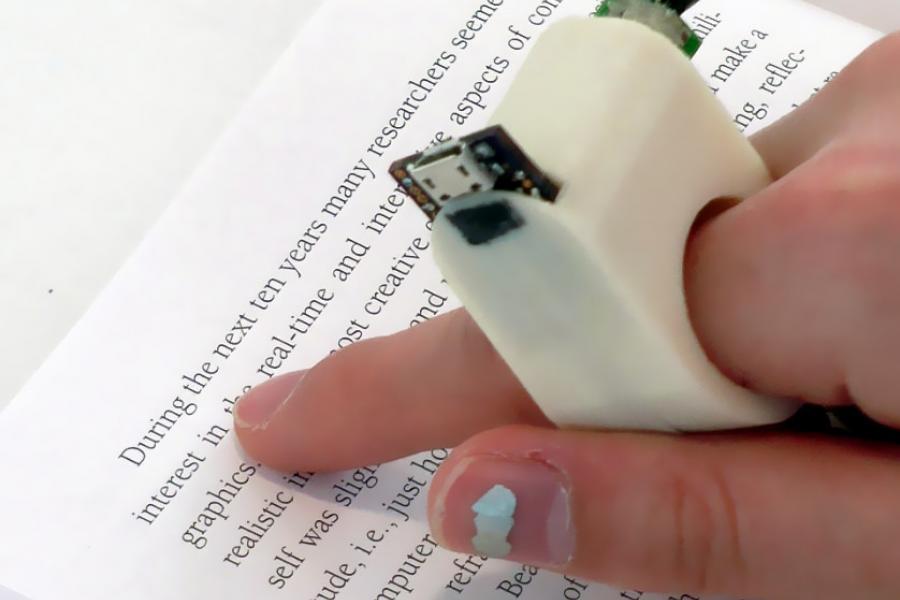Voice-Activated Assistive Devices: Simplifying Everyday Tasks
Voice-Activated Assistive Devices: Simplifying Everyday Tasks
Blog Article
Discover Innovative Devices Designed for the Aesthetically Impaired
The growth of ingenious devices for the visually impaired represents a substantial improvement in accessibility and freedom. Technologies such as clever glasses with AI abilities and mobile applications developed to give auditory summaries are improving everyday experiences for customers. Furthermore, wearable devices that employ haptic comments boost environmental awareness, while modern-day Braille advancements supply brand-new methods to involve with message. As these tools proceed to advance, their effect on the lives of those with aesthetic problems raises important concerns about the future of inclusivity and freedom in different facets of life. What lies in advance in this technological landscape?
Smart Glasses for Navigating

Smart glasses created for navigating are revolutionizing the method visually impaired people communicate with their atmosphere. These innovative devices use a combination of camera modern technology, expert system, and acoustic comments to provide real-time information regarding surroundings. By using obstacle detection systems, clever glasses can alert customers to potential threats, enabling more secure movement in both strange and acquainted setups.
The combination of GPS innovation additionally enhances navigating abilities, permitting users to get auditory instructions as they move. This hands-free strategy not only fosters freedom however also equips aesthetically impaired individuals to navigate city landscapes with enhanced self-confidence. Furthermore, many wise glasses are outfitted with attributes that recognize landmarks and street indications, supplying contextual information that improves the individual experience.
In addition, the growth of these tools is constantly progressing, with companies working to improve the accuracy of object acknowledgment and expand the variety of navigational functions. As wise glasses come to be much more easily accessible and affordable, they hold the possible to considerably transform daily life for aesthetically damaged users. Inevitably, these cutting-edge tools represent a critical step towards inclusivity, offering boosted movement and a higher sense of freedom for individuals browsing the globe around them.

Mobile Application for Daily Living
Exactly how can mobile applications improve the day-to-days live of visually damaged individuals? Mobile apps are reinventing the means visually damaged users navigate their atmospheres, manage daily tasks, and gain access to details. These applications provide essential support through numerous capabilities, fostering independence and boosting quality of life.
Several ingenious mobile applications are created especially for everyday living. For instance, apps like Be My Eyes connect visually damaged individuals with sighted volunteers through video clip telephone calls, allowing them to get real-time support with jobs such as checking out tags or navigating unfamiliar rooms. Seeing AI, established by Microsoft, makes use of man-made knowledge to explain surroundings, reviewed message, and determine things, efficiently changing a smart device right into an effective tool for day-to-day aid.
Furthermore, navigating applications customized for the visually impaired, such as Aira and BlindSquare, use audio-based instructions and ecological info, enabling users to traverse their surroundings securely and confidently. Beyond navigation and prompt help, mobile apps also sustain organization and job administration, with functions that assist customers set tips, produce order of business, and track visits. In summary, mobile applications act as crucial resources, encouraging aesthetically damaged individuals to lead more independent and satisfying lives.
Wearable Technologies for Help
Empowerment with modern technology is progressively apparent in the world of wearable devices developed to help visually impaired individuals. These innovative tools incorporate flawlessly right into every day life, enhancing navigating and supplying important comments to users. As an example, smart glasses geared up with video cameras can recognize faces and check out text out loud, enabling individuals to interact more confidently in professional and social settings.
Another remarkable development is using haptic comments systems in wearable gadgets. These systems utilize resonances or various other tactile signals to share details about the user's setting, such as challenges or adjustments in surface, improving wheelchair and safety and security. Wearable innovations also include wristbands that attach to mobile phones, notifying customers to notifications via subtle resonances, thus boosting connection without dependence on aesthetic signs.
As these modern technologies continue to progress, they are not only improving freedom for aesthetically impaired people yet additionally cultivating a higher feeling of addition in society. By linking the gap between challenges dealt with in everyday living and the potential for freedom, wearable modern technologies work as pivotal devices in the quest for equality and empowerment for those with more information visual disabilities.
Audio Description Tools
Audio summary devices play a critical role in enhancing availability for aesthetically impaired individuals, providing them with the ability to engage with aesthetic media. Smart glasses for the visually impaired. These tools offer narrated summaries of crucial visual elements in films, television shows, and live efficiencies, making certain that users can fully comprehend the context and emotions communicated with visuals
Audio summary can be integrated into numerous systems, consisting of streaming services, cinema screenings, and live movie theater. Many preferred streaming services currently consist of audio description as an accessibility function, enabling visitors to choose it conveniently. Along with traditional media, specialized applications likewise exist, supplying audio descriptions for art exhibitions, museums, and other social events.
The performance of audio description rests on the ability of the storytellers, who should share aesthetic details succinctly without diminishing the original audio. Advancements in this field are also paving the method for even more personalized experiences, where users can readjust the degree of information and pacing according to their choices.
Braille Innovations and Instruments
Braille advancements and gadgets have actually significantly transformed the method visually impaired individuals connect with text and info. Modern improvements have actually led to the development of flexible devices that improve literacy and freedom amongst customers.
Moreover, portable Braille notetakers integrate traditional Braille input with modern functionalities, promoting note-taking, organizing, and file editing and enhancing on the move. Speech-to-text devices for low vision. These small tools often feature text-to-speech abilities, linking the void between Braille and auditory information
Furthermore, ingenious Braille printers have actually emerged, permitting customers to create Braille labels, papers, and academic products successfully. This access promotes better participation in instructional and specialist environments, ultimately promoting inclusivity.
In addition, study into clever Braille technologies remains to increase. Instruments that incorporate fabricated knowledge are being discovered to give real-time navigation help and contextual details, boosting the customer experience in varied setups. On the whole, these developments reflect a dedication to encouraging visually damaged people via innovation, guaranteeing they can conveniently access and engage with the world her response around them.

Final Thought
The advancement of innovative tools for the visually impaired substantially improves independence and top quality of life. These modern technologies not only foster better addition however likewise promote autonomy in daily activities, eventually contributing to a you can find out more more accessible and fair culture for visually impaired individuals.
As smart glasses end up being a lot more easily accessible and budget friendly, they hold the potential to significantly transform daily life for aesthetically damaged users. Mobile apps are revolutionizing the way visually damaged users browse their atmospheres, manage day-to-day tasks, and gain access to information. Applications like Be My Eyes connect aesthetically damaged customers with sighted volunteers by means of video clip calls, permitting them to get real-time help with jobs such as reviewing labels or navigating unfamiliar spaces.Additionally, navigating applications tailored for the aesthetically damaged, such as Aira and BlindSquare, supply audio-based directions and environmental information, enabling customers to traverse their environments safely and confidently.The improvement of cutting-edge devices for the visually damaged dramatically enhances self-reliance and quality of life.
Report this page